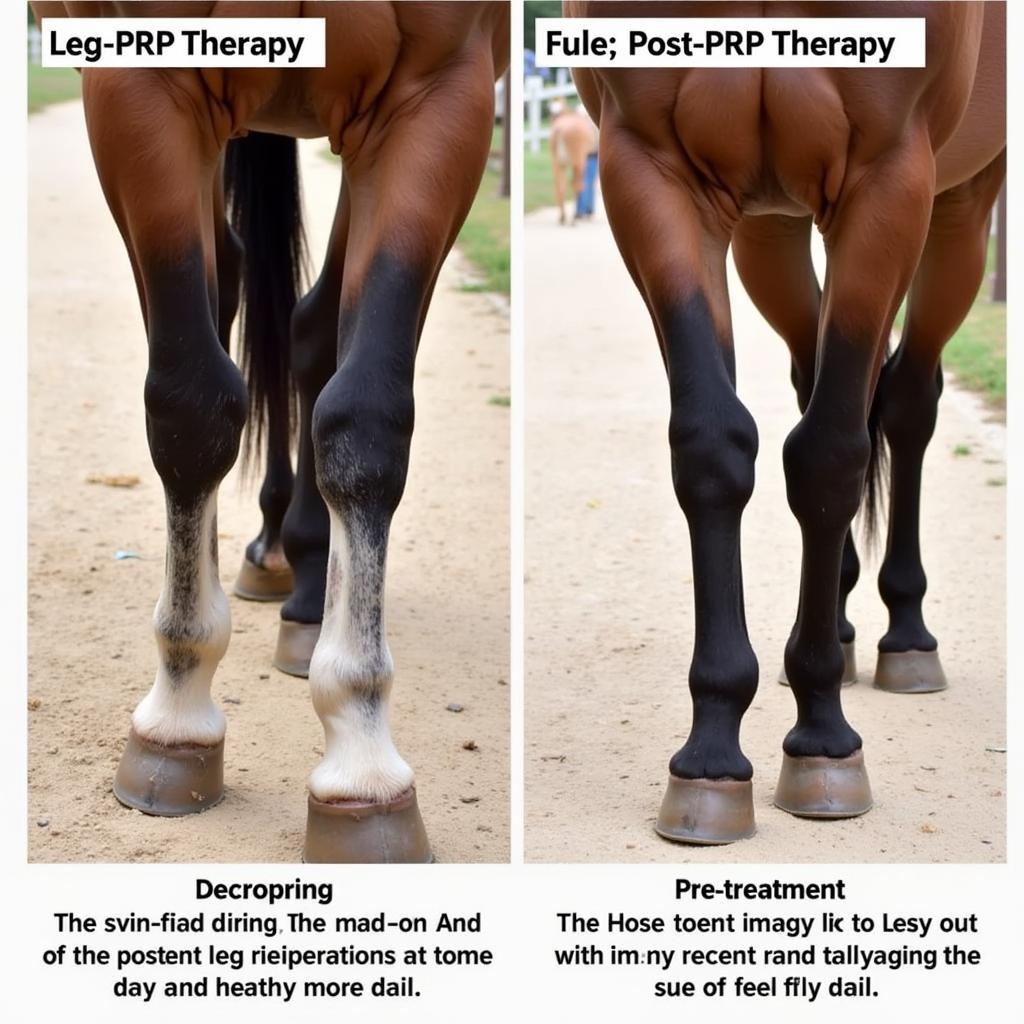Prp Horse therapy, or Platelet-Rich Plasma therapy, is a cutting-edge regenerative treatment gaining popularity in the equine world. It harnesses the healing power of the horse’s own blood to accelerate the recovery of various injuries, from tendon and ligament damage to joint inflammation. This innovative approach minimizes downtime and helps horses return to peak performance.
Understanding PRP Therapy in Horses
PRP therapy involves extracting a small amount of the horse’s blood, then processing it to concentrate platelets. These platelets are rich in growth factors, which are essential for tissue repair and regeneration. This concentrated PRP solution is then injected directly into the injured area, stimulating the body’s natural healing process. This precise application boosts cell growth and reduces inflammation, leading to faster and more effective healing.
What makes PRP horse therapy so attractive is its non-invasive nature and minimal risk of side effects. It complements traditional veterinary practices and offers a promising alternative to more invasive procedures, often minimizing the need for long-term medications like bute. For instance, horses suffering from chronic inferior check ligament injuries can find significant relief through PRP injections, enhancing the effectiveness of other treatments such as controlled exercise and cold therapy.
Similar to how PRP is used to treat horse tendon injury treatment, it can also be applied for extensor tendon horse injuries. PRP therapy can be particularly beneficial in these cases due its ability to stimulate collagen production, crucial for tendon repair.
 PRP Horse Blood Collection Procedure
PRP Horse Blood Collection Procedure
What kinds of injuries does PRP address? PRP is effective for a range of soft tissue injuries, including damaged tendons, ligaments, and joints. It’s also showing promise in treating wounds and osteoarthritis. It’s important to consult with your veterinarian to determine if PRP horse therapy is the right choice for your horse’s specific condition.
 PRP Injection into Horse Leg
PRP Injection into Horse Leg
The PRP Horse Therapy Procedure: Step-by-Step
- Blood Collection: A small sample of blood is drawn from the horse, typically from the jugular vein.
- Centrifugation: The blood sample is placed in a centrifuge to separate the platelet-rich plasma from the other blood components.
- PRP Preparation: The concentrated PRP is carefully extracted and prepared for injection.
- Injection: The PRP is injected directly into the injured area using ultrasound guidance to ensure accurate placement.
The Benefits of PRP in Horses
- Accelerated Healing: PRP significantly speeds up the healing process by stimulating tissue regeneration.
- Reduced Inflammation: PRP contains anti-inflammatory properties that help alleviate pain and swelling.
- Improved Function: By promoting tissue repair, PRP improves the overall function and mobility of the injured area.
- Minimally Invasive: PRP therapy is a non-surgical procedure with minimal downtime.
- Natural Treatment: PRP uses the horse’s own blood, minimizing the risk of adverse reactions.
As Dr. Emily Carter, DVM, specializing in equine sports medicine at Equine Performance Center, explains, “PRP offers a targeted and effective way to harness the body’s natural healing mechanisms. It’s becoming a game-changer in equine injury recovery, providing faster and more complete healing compared to traditional methods.”
 Horse Leg Recovery after PRP
Horse Leg Recovery after PRP
Understanding horse leg muscles is crucial for recognizing and treating injuries. PRP can be an excellent treatment option, but knowing the specific muscle groups affected is vital for targeted therapy. For a better understanding of horse leg muscles and how they can be affected by injuries, check out our article on horse leg muscles.
Is PRP Right for Your Horse?
While PRP offers significant advantages, it’s not suitable for all horses or every type of injury. Conditions such as active infections or certain bleeding disorders might make PRP therapy less effective. Consulting with a veterinarian experienced in PRP treatment is crucial for determining its suitability and developing a tailored treatment plan. Factors like the severity of the injury, the horse’s age, and overall health will be considered.
Conclusion
PRP horse therapy presents a revolutionary approach to equine injury treatment, offering faster healing, reduced inflammation, and improved outcomes. It’s a promising alternative for various injuries, providing a natural and effective way to get your horse back on its feet. If you’re considering PRP therapy for your horse, discuss it with your veterinarian to evaluate its potential benefits. You can also learn more about managing pain and inflammation with our guide on the dosage of bute for horses. This resource can be particularly useful for understanding pain management options before, during, and after PRP treatment.
FAQs
- How long does PRP therapy take? The procedure itself typically takes less than an hour.
- Is PRP painful for horses? Local anesthesia is used to minimize discomfort during the injection.
- How much does PRP therapy cost? The cost varies depending on the veterinarian and the specific case.
- How long does it take to see results? Improvement can often be seen within a few weeks, although full recovery may take several months.
- Are there any side effects of PRP? Side effects are rare and generally mild, such as temporary swelling or soreness at the injection site.
- How many PRP treatments are needed? The number of treatments depends on the injury and the horse’s response.
- Can PRP be used in conjunction with other treatments? Yes, PRP can be used alongside other therapies like physical therapy or medications.
Common Situations for PRP Horse Therapy Questions
- Owners concerned about their horse’s lameness or reduced performance.
- Veterinarians exploring alternative treatment options for tendon and ligament injuries.
- Riders seeking ways to minimize their horse’s recovery time after an injury.
Further Reading
- Learn more about managing tendon injuries in our article on horse tendon injury treatment.
- Explore the anatomy of the inferior check ligament in our dedicated article on the inferior check ligament horse.
Need more information? Contact us for 24/7 support: Phone: 0772127271, Email: [email protected], or visit us at QGM2+WX2, Vị Trung, Vị Thuỷ, Hậu Giang, Việt Nam.